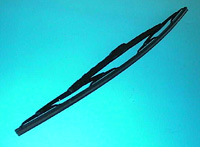 The
wiper blade perhaps was first invented in 1910 that is not long after
the introduction of cars on the road. Essentially it comprises of
a specially designed rubber strip mounted on to a metal frame or wiper
arm. When the rubber blade is placed firmly against the windshield,
it creates a profile that enables it to wipe every point within the
area of vision without smearing. The
wiper blade perhaps was first invented in 1910 that is not long after
the introduction of cars on the road. Essentially it comprises of
a specially designed rubber strip mounted on to a metal frame or wiper
arm. When the rubber blade is placed firmly against the windshield,
it creates a profile that enables it to wipe every point within the
area of vision without smearing.
A good rubber blade wipes the water away from the windshield without leaving any streak or
marking on the windshield. The streak or marking free operation is also attributed to the
design of the wiper arm where an even pressure is applied over the length of the rubber blades
through the wiper arm.
A good windshield wiper blade is therefore a combination of well-formulated rubber blades
and wiper arm.
Manufacturing Process
Traditionally, rubber blades are made of natural rubber (NR) by moulding
process. However, in recent years, many alternative materials such
as EPDM, Silicon, etc. are being used to meet the more stringent demands
imposed by the car manufacturers, including higher heat resistance,
weatherability, continuous wiping behaviour over the life span of
the wiping system. Some of the newer performance blades have a composite
structure that combine a soft, pliable rubber on the squeeze surface
(for good wiping) with a firm rubber in the blade body improved support
and durability.
- Preparation of rubber compound
Mixing is carried out on a two-roll mill or in an internal mixer.
In the case of an internal mixer, it can be done in a single-stage
or double-stage mixing where the masterbatch, which was earlier
prepared in the internal mixer, is finalized by adding curatives
on a two roll mill.
- Determination of scorch time
and cure time
All the above properties are required before going to the subsequent
processes such as moulding, extrusion, etc.
- Shaping and curing of the
rubber blades
The blades can be prepared by compression moulding or extrusion
process with continuous vulcanisation system using LCM or a microwave.
- Precision cutting and trimming
- Surface treatment
NR and EPDM blades usually require surface
treatment process such as chlorination to lower the surface friction
of the wiper blades.
- Assembly on steel frame
 |




